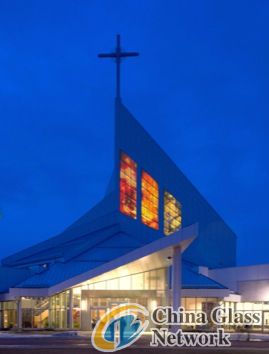
High-tech windows generate electricity using polycrystalline photovoltaic cells
By Michael SwanThe stained glass windows designed by Sarah Hal at Saskatoon's Holy Family Cathedral serve a twofold purpose. Beyond the beauty they add to the cathedral, the windows are embedded with photovoltaic cells that produce about 2,500 kilowatt-hours of power per year. Sarah Hall, The Catholic Register / CCN.
SASKATOON, (CCN)
When the Catholics of Saskatoon gather under the sign of the cross at their new cathedral they will have both science and art to thank.
With the prairie sun shining through three huge stained glass windows in the upper reaches of Holy Family Cathedral, crosses of light will fall on the people, the altar, the walls and the doors of the sanctuary, moving from place to place according to the time of day and the season.
"They're quite mysterious because they don't just stay in one place," said Toronto-based stained glass artist Sarah Hall. "As the sun moves and the seasons change, they change."
Hall made the crosses out of dichroic glass, a high-tech material developed by NASA for the space program. The material has the ability to block certain wavelengths of light while allowing others to pass through. The result is glass that is one colour on the outside but projects light of a different colour on the inside.
The science of Hall's monumental windows for the new cathedral doesn't stop with the high tech glass. These windows are also generating electricity.
A grid of 1,113 polycrystalline photovoltaic cells is embedded in the windows. The windows are linked to the Saskatoon Light and Power electricity grid and are expected to produce about 2,500 kilowatt-hours of energy annually. In Saskatoon solar energy generation holds huge potential given a yearly average of 2,381 hours of sunshine.
Hall gave the windows the title Lux Gloria (Light of Glory). For the cathedral parish the project was about more than saving money on energy bills or the kind of churchly ambience created by coloured glass, said Hall.
"There were real concerns about stewardship," she said. "They had looked at solar panels on the roof but there was not good integration to bring those conventional solar roof-top panels onto the roof. I think they had almost set that idea to the side. But I was working on integrating it together with art glass."
The decision to go with solar power-generating stained glass was a statement about stewardship of natural resources and the community's relationship with the Earth, said Holy Family Cathedral facilities manager Jim Nakoneshny.
"It was one of the most prominent architectural features of the building, front and centre," said Nakoneshny. "We thought it would be nice to bring some focus to the stewardship aspect of it."
Nakoneshny doesn't expect the windows to generate huge amounts of electricity.
The decision to include photovoltaic cells wasn't difficult. In the end the windows cost about $46.50 per square metre ($500 per square foot), about the same as any original stained glass work.
Hall has been producing stained glass that generates electricity for the last seven years. Working with a German studio and solar energy engineer Christof Erban, Hall landed a Natural Resources Canada grant for her first solar energy art glass project, which she combined with funding from McGill University and the Chalmers Art Foundation.
Making solar panels look good isn't easy.
"It is a challenge for sure," Hall said. "Most solar cells are just kind of dark cells sitting on aluminum. Mounted on a roof they don't necessarily look good. They don't look integrated at all. Nobody's thought about how they can come together with the architecture."
Hall has completed six projects using the new technology. The Holy Family Cathedral project is the latest. It went online with Saskatchewan's power grid in July.
The power-generating stained glass isn't right for every church or building. To generate any meaningful amount of electricity the windows must be exceptionally large, they must face south or east and they can't fall under the shadow of other buildings. The Saskatoon cathedral was the perfect building for a solar stained glass project.
"It was the perfect solution for that particular place," said Hall.
Hall is now looking at the possibility of applying the same technology to a renovation project at the parish of St. Margaret Mary in Woodbridge, Ont.
The Holy Family windows have generated lots of interest in Saskatoon, where Nakoneshny greets visitors who drive in off the street to have a look for themselves. On the exterior the crosses show up as golden reflections that catch the eye amid the various colours. Unlike most stained glass designed to be viewed from the inside, these windows were designed as almost a beacon of colour directed at the world outside the cathedral.
"They are quite visible from the outside in certain lighting conditions. It is something that jumps out at you," said Nakoneshny.
Holy Family serves 1,900 Saskatoon families and seats 1,100 for Mass.





